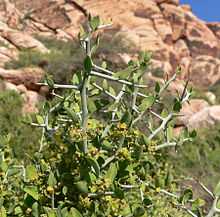Ziziphus obtusifolia
| Ziziphus obtusifolia | |
|---|---|
 | |
| var. canescens | |
| Scientific classification | |
| Kingdom: | Plantae |
| (unranked): | Angiosperms |
| (unranked): | Eudicots |
| (unranked): | Rosids |
| Order: | Rosales |
| Family: | Rhamnaceae |
| Genus: | Ziziphus |
| Species: | Z. obtusifolia |
| Binomial name | |
| Ziziphus obtusifolia (Hook. ex Torr. & A.Gray) A. Gray | |
Ziziphus obtusifolia is a species of flowering plant in the buckthorn family known by several common names, including lotebush, graythorn, gumdrop tree, and Texas buckthorn.[1] It is native to the southwestern United States and much of Mexico, where it grows in shrubby and scrubby desert habitat, grasslands and prairie, woodlands, and other habitat types. It can be found among desert plants such as honey mesquite, smooth mesquite, ocotillo and creosote.[1] This is a shrub with many branches forming a thorny tangle which may exceed 3 meters tall and approach 4 meters at times. The leaves are deciduous and are absent for much of the year, leaving the shrub a naked thicket of gray twigs coated in waxy whitish hairs. The ends of the twigs taper into sharp-tipped thorns. The thick, glandular gray or green leaves have oval blades 1 or 2 centimeters long. The inflorescence is a cluster of several dull yellow-green flowers. The fruit is a mealy, juicy drupe containing one seed.
The fruit provides food for many species of birds and mammals.[1] Birds use the shrub as a nesting site and the southern plains woodrat uses the twigs to build its houses.[1]
| Wikimedia Commons has media related to Ziziphus obtusifolia. |